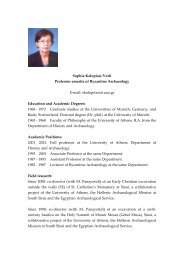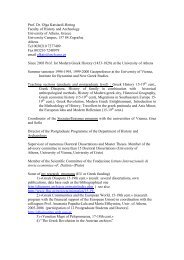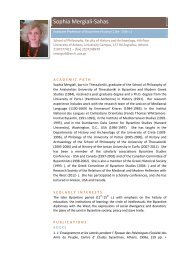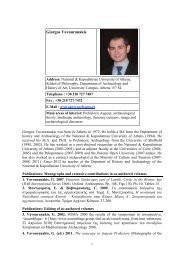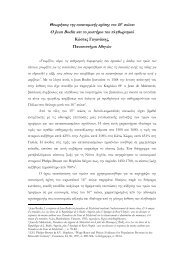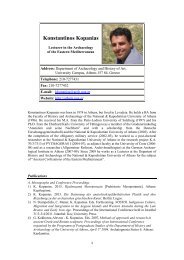From Water in Greek Religion, Ancient and Modern, to the ... - Journals
From Water in Greek Religion, Ancient and Modern, to the ... - Journals
From Water in Greek Religion, Ancient and Modern, to the ... - Journals
Create successful ePaper yourself
Turn your PDF publications into a flip-book with our unique Google optimized e-Paper software.
56 Comparative Civilizations Review<br />
FROM WATER IN GREEK RELIGION, ANCIENT AND<br />
MODERN, TO THE WIDER MEDITERRANEAN AND BEYOND<br />
EVY JOHANNE HALAND<br />
CENTER FOR DEVELOPMENT STUDIES<br />
UNIVERSITY OF BERGEN, NORWAY<br />
EVYHAA@ONLINE.NO<br />
The Life-giv<strong>in</strong>g Spr<strong>in</strong>g at A<strong>the</strong>ns<br />
In Greece, spr<strong>in</strong>gs <strong>in</strong> caves have traditionally shaped religious<br />
beliefs <strong>and</strong> practices. In ancient times spr<strong>in</strong>gs represented <strong>Water</strong>-<br />
Nymphs. Today spr<strong>in</strong>gs are dedicated <strong>to</strong> <strong>the</strong> Panagia (<strong>the</strong> Virg<strong>in</strong> Mary),<br />
under her attribute of Zodochos Pege (<strong>the</strong> Life-giv<strong>in</strong>g Spr<strong>in</strong>g). <strong>Ancient</strong><br />
<strong>and</strong> modern believers have expressed <strong>the</strong>ir beliefs <strong>in</strong> rituals connected <strong>to</strong><br />
purity <strong>and</strong> water by fetch<strong>in</strong>g holy water from <strong>the</strong> caves dedicated <strong>to</strong><br />
<strong>the</strong>se female div<strong>in</strong>ities. Panagia's A<strong>the</strong>nian chapel is situated <strong>in</strong>side a<br />
circular Spr<strong>in</strong>g House hewn <strong>in</strong> <strong>the</strong> rock on <strong>the</strong> sou<strong>the</strong>rn slope of <strong>the</strong><br />
Acropolis.<br />
<strong>Water</strong> is a significant <strong>to</strong>pic both <strong>in</strong> <strong>the</strong> humanities <strong>and</strong> social sciences<br />
<strong>and</strong> might be studied from a comparative civilizational perspective,<br />
such as <strong>in</strong> relation <strong>to</strong> comparative civilizations of water. Every<br />
aspect of human life <strong>and</strong> div<strong>in</strong>e <strong>in</strong>terferences on earth is possible <strong>to</strong><br />
express with water symbolism, <strong>and</strong> religious rituals <strong>and</strong> beliefs <strong>in</strong> connection<br />
with water are found cross-culturally, be that <strong>in</strong> Asia, such as <strong>in</strong><br />
Japan, <strong>in</strong> <strong>the</strong> Middle East <strong>and</strong> Mediterranean areas, as well as <strong>in</strong> Lat<strong>in</strong><br />
America. In o<strong>the</strong>r words, rituals <strong>in</strong> connection with <strong>the</strong> religious significance<br />
of water recur across several civilizations <strong>and</strong> religious group<strong>in</strong>gs.<br />
With this <strong>in</strong> m<strong>in</strong>d, <strong>the</strong> article will compare <strong>the</strong> importance of <strong>the</strong><br />
spr<strong>in</strong>g <strong>in</strong> <strong>the</strong> modern rituals <strong>in</strong> <strong>the</strong> Acropolis cave <strong>to</strong> <strong>the</strong> ancient cult of<br />
<strong>the</strong> spr<strong>in</strong>g <strong>in</strong> <strong>the</strong> actual cave. The comparison will also exploit <strong>the</strong> cult<br />
of spr<strong>in</strong>gs <strong>in</strong> o<strong>the</strong>r <strong>Greek</strong> caves <strong>and</strong> similar cult found <strong>in</strong> non-<strong>Greek</strong> contexts.<br />
Thus, by br<strong>in</strong>g<strong>in</strong>g ancient <strong>and</strong> modern worlds <strong>in</strong><strong>to</strong> mutual illum<strong>in</strong>ation,<br />
also by mak<strong>in</strong>g comparisons with material from <strong>the</strong> rest of <strong>the</strong><br />
Mediterranean area <strong>and</strong> <strong>the</strong> Middle East, <strong>the</strong> article has relevance<br />
beyond <strong>the</strong> <strong>Greek</strong> context both <strong>in</strong> time <strong>and</strong> space. 1<br />
Clean<strong>in</strong>g <strong>the</strong> Acropolis Caves<br />
Saturday 4 April 1992, Eir<strong>in</strong>e Melas carries out <strong>the</strong> monthly clean<strong>in</strong>g<br />
of <strong>the</strong> Acropolis caves. In <strong>the</strong> morn<strong>in</strong>g, I arrive <strong>to</strong>ge<strong>the</strong>r with my<br />
visit<strong>in</strong>g mo<strong>the</strong>r <strong>and</strong> Eir<strong>in</strong>e's daughter Maria <strong>to</strong> <strong>the</strong> cave, which is called
Evy Johanne H&l<strong>and</strong> 57<br />
<strong>the</strong> Life-giv<strong>in</strong>g Spr<strong>in</strong>g, due <strong>to</strong> <strong>the</strong> Sacred Spr<strong>in</strong>g. 2 Eir<strong>in</strong>e says that it is<br />
dedicated <strong>to</strong> Agioi (cf. Agios, i.e. Sa<strong>in</strong>t) Anargyroi, <strong>the</strong> patron sa<strong>in</strong>ts of<br />
heal<strong>in</strong>g. 3 Eir<strong>in</strong>e has been clean<strong>in</strong>g <strong>the</strong> caves regularly s<strong>in</strong>ce her deceased<br />
husb<strong>and</strong> worked at <strong>the</strong> Acropolis. Today, two o<strong>the</strong>r women also arrive,<br />
<strong>and</strong> a young man, Panagiotis. Dur<strong>in</strong>g our stay, he presents several newspaper<br />
cutt<strong>in</strong>gs about <strong>the</strong> "cave-churches." 4 I always have regarded <strong>the</strong><br />
two caves as caves, but my <strong>in</strong>formants always refer <strong>to</strong> <strong>the</strong>m as churches.<br />
Despite Panagiotis' participation, <strong>the</strong> ma<strong>in</strong> performers of <strong>the</strong> rituals<br />
<strong>in</strong> <strong>the</strong> caves are women. When <strong>the</strong>y reach <strong>the</strong> cave this morn<strong>in</strong>g, everyone<br />
washes <strong>in</strong> <strong>the</strong> spr<strong>in</strong>g <strong>and</strong> dr<strong>in</strong>ks <strong>the</strong> water. The two women assert<br />
that <strong>the</strong> water is miracle-work<strong>in</strong>g <strong>and</strong> heal<strong>in</strong>g. They also state that, s<strong>in</strong>ce<br />
childhood <strong>the</strong>y have been brought <strong>to</strong> <strong>the</strong> Life-giv<strong>in</strong>g Spr<strong>in</strong>g <strong>to</strong> fetch<br />
holy water along with <strong>the</strong>ir mo<strong>the</strong>rs: "It has always been like this". The<br />
first declaration is a clear <strong>in</strong>stance of how <strong>Greek</strong> children are socialised.<br />
The comment about "how it always has been" is a general remark that<br />
most <strong>in</strong>formants give when a researcher asks how old a cus<strong>to</strong>m is. This<br />
may very often be a problem when convers<strong>in</strong>g with <strong>Greek</strong> <strong>in</strong>formants<br />
who do not necessarily always th<strong>in</strong>k, or "see," <strong>in</strong> a "European his<strong>to</strong>rical<br />
l<strong>in</strong>ear" way, but have <strong>the</strong>ir own, very often, local his<strong>to</strong>ry. 5<br />
They expla<strong>in</strong> that among <strong>the</strong> many icons <strong>in</strong> <strong>the</strong> cave, <strong>the</strong> most holy<br />
represents <strong>the</strong> Panagia <strong>and</strong> <strong>the</strong> Child. In front of <strong>the</strong> icon, one of <strong>the</strong><br />
women arranges a bunch of flowers. So, even if we have just learned<br />
that <strong>the</strong> cave still is dedicated <strong>to</strong> Agioi Anargyroi, <strong>the</strong> Panagia is <strong>the</strong> one<br />
who gets <strong>the</strong> gifts. Fur<strong>the</strong>r, <strong>the</strong> icons of <strong>the</strong> Panagia are ma<strong>in</strong>ly dedicated<br />
<strong>in</strong> <strong>the</strong> tamata (i.e. metal plaques depict<strong>in</strong>g a vow or request, votive<br />
offer<strong>in</strong>gs), even if <strong>the</strong> icon of Agioi Anargyroi still is <strong>in</strong> <strong>the</strong> cave. The<br />
most common offer<strong>in</strong>g is a silver- or gold-plated ex-vo<strong>to</strong> represent<strong>in</strong>g<br />
<strong>the</strong> person who has been miraculously cured by <strong>the</strong> icon <strong>in</strong> comb<strong>in</strong>ation<br />
with <strong>the</strong> water, or <strong>the</strong> cured limb itself or <strong>the</strong> person or limb want<strong>in</strong>g <strong>to</strong><br />
be cured. They light c<strong>and</strong>les <strong>in</strong> front of <strong>the</strong> icon <strong>and</strong> <strong>the</strong>y light <strong>the</strong> oliveoil<br />
lamps. They fill water <strong>in</strong> bottles, while say<strong>in</strong>g that, "even if it is not<br />
ra<strong>in</strong><strong>in</strong>g, <strong>the</strong>re will always be water <strong>in</strong> <strong>the</strong> cave."<br />
The cave is situated with<strong>in</strong> <strong>the</strong> archaeological quarter, <strong>and</strong> generally<br />
<strong>the</strong> entrance is locked up with bars <strong>and</strong> padlocks. Therefore, it was<br />
necessary <strong>to</strong> obta<strong>in</strong> a special permission from <strong>the</strong> representatives of <strong>the</strong><br />
M<strong>in</strong>istry of Culture <strong>to</strong> do research <strong>in</strong> <strong>the</strong> two caves situated on <strong>the</strong><br />
sou<strong>the</strong>rn slope of <strong>the</strong> Acropolis, a task which was not easy. Even though<br />
<strong>the</strong> representatives of <strong>the</strong> authorities were very helpful, it <strong>to</strong>ok some<br />
time before <strong>the</strong>y unders<strong>to</strong>od my request. Several found it quite <strong>in</strong>comprehensible<br />
that I was not <strong>in</strong>terested <strong>in</strong> only talk<strong>in</strong>g with <strong>the</strong> archaeolo-
58 Comparative Civilizations Review<br />
gists who work at <strong>the</strong> site, but also with <strong>the</strong> woman who regularly is<br />
clean<strong>in</strong>g <strong>the</strong> caves <strong>and</strong> with people who have been used <strong>to</strong> fetch water<br />
<strong>the</strong>re s<strong>in</strong>ce childhood. That I was as <strong>in</strong>terested <strong>in</strong> establish<strong>in</strong>g contact<br />
with liv<strong>in</strong>g people practis<strong>in</strong>g <strong>the</strong>ir religion <strong>in</strong> <strong>the</strong> same caves where particularly<br />
<strong>the</strong> <strong>Water</strong>-Nymphs once were worshipped, as <strong>in</strong> all <strong>the</strong> archaeological<br />
ru<strong>in</strong>s, which are mute compared <strong>to</strong> <strong>the</strong> traditional cult practised<br />
<strong>in</strong> <strong>the</strong> cave with Life-giv<strong>in</strong>g water, was <strong>in</strong>comprehensible. One may add<br />
that, certa<strong>in</strong>ly, <strong>the</strong> archaeologists do unearth <strong>the</strong> <strong>Ancient</strong> Greatness, but<br />
I would claim that it also had a fundament, people's traditional rituals. 6<br />
While Eir<strong>in</strong>e lights c<strong>and</strong>les <strong>and</strong> fetches water <strong>in</strong> <strong>the</strong> cave, we chat<br />
about <strong>the</strong> annual festival, dedicated <strong>to</strong> <strong>the</strong> "Life-giv<strong>in</strong>g Spr<strong>in</strong>g," which<br />
will take place here <strong>in</strong> a month's time. However, it is not yet decided if<br />
<strong>the</strong> festival will be celebrated this year, due <strong>to</strong> two practical problems,<br />
one of <strong>the</strong>m be<strong>in</strong>g <strong>the</strong> actual date of <strong>the</strong> festival <strong>in</strong> 1992. Ano<strong>the</strong>r problem<br />
is <strong>the</strong> relationship between <strong>the</strong> new parish priest <strong>and</strong> <strong>the</strong> celebrants:<br />
7<br />
Accord<strong>in</strong>g <strong>to</strong> Maria, <strong>the</strong> old priest <strong>in</strong> <strong>the</strong> Byzant<strong>in</strong>e Church of Agios<br />
Nikolaos on Plaka always officiated dur<strong>in</strong>g <strong>the</strong> festival, but now he is<br />
very old, <strong>and</strong> his successor resists participat<strong>in</strong>g at <strong>the</strong> festival, claim<strong>in</strong>g<br />
that it represents a pagan cus<strong>to</strong>m. In 1991, he stated that he was ill. Even<br />
if <strong>the</strong>re is a close relationship between <strong>the</strong> official Orthodox religion<br />
<strong>and</strong> popular religion, this situation still is a general problem we also see<br />
dur<strong>in</strong>g o<strong>the</strong>r <strong>Greek</strong> festivals. In 1991, <strong>the</strong> festival f<strong>in</strong>ally was successfully<br />
celebrated because <strong>the</strong>y <strong>in</strong>vited a priest from <strong>the</strong> University of<br />
8<br />
Piraeus <strong>to</strong> officiate at <strong>the</strong> ceremony. However, <strong>the</strong>y still do not know<br />
what will happen this year.<br />
After a while, Eir<strong>in</strong>e fills holy water <strong>in</strong><strong>to</strong> a bucket, <strong>and</strong> along with<br />
a broom, soap, etc., we carry it with us while climb<strong>in</strong>g up <strong>to</strong> <strong>the</strong> o<strong>the</strong>r<br />
cave-church, which opens above <strong>the</strong> <strong>the</strong>atre of <strong>the</strong> ancient god,<br />
Dionysos. This is <strong>the</strong> cave dedicated <strong>to</strong> <strong>the</strong> Panagia Crysospelidtissa, or<br />
Chapel of Our Lady of <strong>the</strong> Cavern. With<strong>in</strong>, Eir<strong>in</strong>e lights every even<strong>in</strong>g<br />
a lamp.<br />
The churches are from <strong>the</strong> 5'" or <strong>the</strong> 6'" century. In both churches we<br />
see a newspaper article framed <strong>and</strong> glazed. Panagiotis tells that he hung<br />
it up. He does not remember when <strong>and</strong> where <strong>the</strong> article was published,<br />
only that he "found it some years ago," "<strong>the</strong> year I was on T<strong>in</strong>os dur<strong>in</strong>g<br />
<strong>the</strong> Panagia" (i.e. 15.08.1989). The article describes <strong>the</strong> legend beh<strong>in</strong>d<br />
9<br />
<strong>the</strong> cult dedicated <strong>to</strong> <strong>the</strong> Panagia Crysospeliotissa <strong>in</strong> this particular cave.<br />
Eir<strong>in</strong>e <strong>and</strong> Panagiotis recount <strong>the</strong> article <strong>in</strong> <strong>the</strong>ir own way: "In <strong>the</strong><br />
beg<strong>in</strong>n<strong>in</strong>g of Christianity <strong>the</strong>re was a miraculous icon <strong>in</strong> this cave. It<br />
was pa<strong>in</strong>ted by Agios (i.e., <strong>the</strong> Evangelist) Luke (i.e., dur<strong>in</strong>g Mary's
Evy Johanne Hiil<strong>and</strong> 59<br />
lifetime). Roxanne, <strong>the</strong> daughter of a pagan medical doc<strong>to</strong>r, dreamt of<br />
Panagia who asked her "<strong>to</strong> set her free." "She was imprisoned." In o<strong>the</strong>r<br />
words, <strong>the</strong> icon was buried here. 10 After three dreams, she asked <strong>the</strong><br />
o<strong>the</strong>r Christians <strong>to</strong> go along with her, dug <strong>and</strong> found <strong>the</strong> icon. Then, <strong>the</strong><br />
Panagia appeared <strong>to</strong> her <strong>in</strong> a vision. She promised <strong>to</strong> help Roxanne <strong>to</strong><br />
liberate A<strong>the</strong>ns. When Alaric came, he wanted <strong>to</strong> destroy <strong>the</strong> city. But a<br />
light appeared before <strong>the</strong>m," Alaric saw <strong>the</strong> Panagia on <strong>the</strong> city-wall,<br />
<strong>and</strong> Alaric departed. Accord<strong>in</strong>g <strong>to</strong> <strong>the</strong> article he left because he was a<br />
Christian <strong>and</strong> believed <strong>in</strong> <strong>the</strong> Panagia. The article also tells that many of<br />
<strong>the</strong> pagan A<strong>the</strong>nians <strong>in</strong>terpreted <strong>the</strong> miracle <strong>in</strong> <strong>the</strong>ir own way, <strong>and</strong> <strong>the</strong>y<br />
thought that <strong>the</strong> protect<strong>in</strong>g city goddess on <strong>the</strong> Acropolis, A<strong>the</strong>na, had<br />
appeared on <strong>the</strong> city-wall. The miracle happened <strong>in</strong> August 395 <strong>and</strong><br />
<strong>the</strong>refore 15 August is celebrated here <strong>in</strong> commemoration of <strong>the</strong> miracle.<br />
12 In addition <strong>to</strong> <strong>the</strong> problematical dat<strong>in</strong>g of <strong>the</strong> article, we also met<br />
<strong>the</strong> particular <strong>in</strong>terpretation my <strong>in</strong>formants put <strong>in</strong><strong>to</strong> <strong>the</strong> article, i.e. <strong>the</strong><br />
relation between <strong>the</strong> pagans <strong>and</strong> <strong>the</strong> Christians <strong>and</strong> <strong>the</strong>ir emphasiz<strong>in</strong>g of<br />
<strong>the</strong> magical power of <strong>the</strong> icon. Accord<strong>in</strong>gly, <strong>the</strong>y also say that <strong>the</strong> icon<br />
was bought <strong>to</strong> <strong>the</strong> cave when people who did not believe <strong>in</strong> Christianity<br />
were present. The article does not say anyth<strong>in</strong>g about that, but it tells<br />
how <strong>the</strong> icon was help<strong>in</strong>g <strong>the</strong> A<strong>the</strong>nians <strong>to</strong> save <strong>the</strong> city aga<strong>in</strong>st <strong>the</strong><br />
assault of <strong>the</strong> Goths.<br />
In <strong>the</strong> cave dedicated <strong>to</strong> Panagia Crysospeliotissa, <strong>the</strong>y perform <strong>the</strong><br />
memorial service called "N<strong>in</strong>e days after <strong>the</strong> Dormition", i.e. on 23<br />
August. Earlier, <strong>the</strong>re were two s<strong>to</strong>reys separated by a wooden-floor <strong>in</strong><br />
this chapel. Eir<strong>in</strong>e expla<strong>in</strong>s that this church "is named after <strong>the</strong> death or<br />
'Dormition' of <strong>the</strong> Panagia, because <strong>the</strong> icon depicts her death." They<br />
decorate <strong>the</strong> icon with lamps <strong>and</strong> flowers. They also decorate <strong>the</strong> rest of<br />
<strong>the</strong> cave, leav<strong>in</strong>g all <strong>the</strong> lamps <strong>in</strong> front of <strong>the</strong> icon of <strong>the</strong> Panagia <strong>and</strong> <strong>the</strong><br />
Child.<br />
The first time I was visit<strong>in</strong>g <strong>the</strong> cave, August 1990,1 also saw icons<br />
dedicated <strong>to</strong> <strong>the</strong> Panagia Ath<strong>in</strong>otissa <strong>and</strong> Agios Attikos. Several icons<br />
were hang<strong>in</strong>g over older Byzant<strong>in</strong>e frescos, which are not res<strong>to</strong>red (i.e.<br />
<strong>in</strong> 1992). It is worth not<strong>in</strong>g that <strong>the</strong> religious symbols, miracles, etc. are<br />
extremely important <strong>to</strong> <strong>the</strong> believers, <strong>and</strong> <strong>in</strong> <strong>the</strong> very straightforward<br />
way <strong>the</strong>y relate everyth<strong>in</strong>g: it is self-evident. Hence, dur<strong>in</strong>g my visit<br />
<strong>the</strong>y tell several s<strong>to</strong>ries, <strong>and</strong> Panagiotis supplies me with several pictures<br />
of different sa<strong>in</strong>ts <strong>and</strong> o<strong>the</strong>r gifts. I learn that some years ago,<br />
Eir<strong>in</strong>e found all <strong>the</strong> icons broken when she arrived at <strong>the</strong> cave-church.<br />
By way of helpful people, Eir<strong>in</strong>e managed <strong>to</strong> repair some of <strong>the</strong> icons,<br />
<strong>and</strong> she received several new ones. When Eir<strong>in</strong>e has f<strong>in</strong>ished sweep<strong>in</strong>g,
60 Comparative Civilizations Review<br />
she spr<strong>in</strong>kles water from <strong>the</strong> Life-giv<strong>in</strong>g Spr<strong>in</strong>g all over. Afterwards, we<br />
return downhill <strong>to</strong> <strong>the</strong> first church.<br />
When leav<strong>in</strong>g Eir<strong>in</strong>e <strong>and</strong> Panagiotis, she wishes us "Happy Easter"<br />
<strong>and</strong> adds, as most faithful <strong>Greek</strong>s do, "Kalos Anestase," "i.e. Happy<br />
Resurrection."<br />
"New" Friday <strong>in</strong> <strong>the</strong> "White Week:" <strong>the</strong> Celebration of <strong>the</strong> Lifegiv<strong>in</strong>g<br />
Spr<strong>in</strong>g<br />
In Greece, <strong>the</strong> first week after <strong>the</strong> Resurrection of Christ on Easter<br />
Sunday is known as <strong>the</strong> "White Week." On "New" Friday <strong>in</strong> <strong>the</strong> "White<br />
Week" <strong>the</strong>y feast <strong>the</strong> Virg<strong>in</strong> Mary under her attribute of <strong>the</strong> Life-giv<strong>in</strong>g<br />
Spr<strong>in</strong>g. In A<strong>the</strong>ns, <strong>the</strong> festival is celebrated <strong>in</strong> a particular way, s<strong>in</strong>ce <strong>the</strong><br />
church dedicated <strong>to</strong> <strong>the</strong> Life-giv<strong>in</strong>g Spr<strong>in</strong>g is situated <strong>in</strong>side <strong>the</strong> archaeological<br />
site of <strong>the</strong> Acropolis.<br />
In 1992, Friday after Easter co<strong>in</strong>cided with May I s ', or <strong>the</strong> Workers<br />
Day. This is a general holiday also for <strong>the</strong> guards work<strong>in</strong>g at <strong>the</strong><br />
Acropolis area. This is important, because of <strong>the</strong> location of <strong>the</strong> cave. In<br />
March, <strong>the</strong> guards <strong>to</strong>ld me that <strong>the</strong> Acropolis area would be closed for<br />
visi<strong>to</strong>rs on May I s '. It seemed that <strong>the</strong> Cura<strong>to</strong>r of Antiquities of <strong>the</strong><br />
Acropolis found it difficult <strong>to</strong> decide whe<strong>the</strong>r <strong>the</strong> festival would be celebrated<br />
<strong>and</strong> people would be allowed <strong>to</strong> come <strong>in</strong><strong>to</strong> <strong>the</strong> area <strong>and</strong> fetch<br />
holy water.<br />
So, how will it turn out? Will <strong>the</strong> ideology related <strong>to</strong> <strong>the</strong> "holiday<br />
of <strong>the</strong> workers," as it is adapted <strong>to</strong> <strong>the</strong> <strong>Greek</strong> nation-state, submit <strong>to</strong> <strong>the</strong><br />
traditional popular cus<strong>to</strong>m, or will <strong>the</strong> new ideology related <strong>to</strong> Western<br />
Europe be <strong>the</strong> w<strong>in</strong>ner?" Both festivals represent "<strong>the</strong> people," but one<br />
is related <strong>to</strong> a nationalist ideology conform<strong>in</strong>g <strong>to</strong> a Western ideology,<br />
while <strong>the</strong> o<strong>the</strong>r represents <strong>the</strong> <strong>in</strong>ward-fac<strong>in</strong>g identity, <strong>the</strong> "Roman"<br />
image of Greece that "echoes" <strong>the</strong> Byzant<strong>in</strong>e Empire <strong>and</strong> hence <strong>the</strong><br />
Orthodox Christian tradition <strong>to</strong> which <strong>the</strong> majority of <strong>Greek</strong>s still<br />
adhere (cf. Herzfeld 1992).<br />
F<strong>in</strong>ally <strong>the</strong> Acropolis authorities decide <strong>to</strong> keep <strong>the</strong> area open, <strong>and</strong><br />
<strong>the</strong> popular religiosity triumphs. The festival is celebrated from 8:30<br />
until 11:00. The guards are on duty at <strong>the</strong> entrances <strong>to</strong> <strong>the</strong> Acropolis.<br />
Here, <strong>the</strong> <strong>Greek</strong>s from <strong>the</strong> neighbourhood are separated from <strong>the</strong> rest of<br />
<strong>the</strong> people outside <strong>the</strong> gates. To <strong>the</strong> many frustrated <strong>to</strong>urists, wait<strong>in</strong>g<br />
outside <strong>the</strong> gates, <strong>the</strong> message given is clear: "only <strong>Greek</strong>s are admitted,<br />
s<strong>in</strong>ce it is <strong>the</strong>ir festival." 14 The "Roman" tradition ga<strong>in</strong>s <strong>the</strong> vic<strong>to</strong>ry<br />
over <strong>the</strong> "Hellenic," <strong>the</strong> Roman identity is not placed at <strong>the</strong> disposal<br />
of foreigners, as <strong>the</strong> <strong>Greek</strong>s do with <strong>the</strong> "common <strong>Ancient</strong> heritage,"
Evy Johanne Hiil<strong>and</strong> 61<br />
which is "outward-directed." Consequently, one may claim that <strong>the</strong><br />
15<br />
"ideology of <strong>the</strong> workers" became "subjugated" by <strong>the</strong> traditional religious<br />
cus<strong>to</strong>m, which is connected with deep-seated values, <strong>the</strong> last<strong>in</strong>g<br />
mentalities: people's need <strong>to</strong> fetch Life-giv<strong>in</strong>g water from <strong>the</strong> spr<strong>in</strong>g on<br />
this specific festival, when <strong>the</strong> water is thought <strong>to</strong> be particularly heal<strong>in</strong>g<br />
<strong>and</strong> purify<strong>in</strong>g. However, <strong>the</strong> faithful did not only have <strong>to</strong> compete<br />
16<br />
with <strong>the</strong> political ideology, but also <strong>the</strong> religious, s<strong>in</strong>ce <strong>the</strong> parish priest<br />
decl<strong>in</strong>ed <strong>to</strong> officiate. Accord<strong>in</strong>gly he had <strong>to</strong> be replaced by ano<strong>the</strong>r.<br />
Dur<strong>in</strong>g <strong>the</strong> celebration many people are present. The officiat<strong>in</strong>g<br />
priest is <strong>the</strong> same as <strong>the</strong> year before. Outside <strong>the</strong> entrance <strong>to</strong> <strong>the</strong> cavechurch<br />
several tables are set up. They are laid with a variety of breads<br />
17<br />
<strong>and</strong> cakes brought by <strong>the</strong> participants, particularly <strong>the</strong> round holy bread,<br />
prosphoro, which always is offered <strong>to</strong> <strong>the</strong> church <strong>and</strong> blessed by <strong>the</strong><br />
priest. Inside <strong>the</strong> church several c<strong>and</strong>les are lit. At <strong>the</strong> altar, <strong>in</strong> front of<br />
<strong>the</strong> wall beh<strong>in</strong>d which is <strong>the</strong> spr<strong>in</strong>g, <strong>the</strong> priest is officiat<strong>in</strong>g. When he<br />
concludes <strong>the</strong> mass, he starts <strong>to</strong> assemble <strong>the</strong> rest of <strong>the</strong> holy bread,<br />
which he has blessed <strong>and</strong> distributed <strong>to</strong> <strong>the</strong> participants. He also packs<br />
up his briefcase, which is situated <strong>in</strong> <strong>the</strong> middle of <strong>the</strong> altar.<br />
But, people are still flow<strong>in</strong>g <strong>in</strong><strong>to</strong> <strong>the</strong> cave <strong>to</strong> fetch water, although<br />
most of <strong>the</strong> participants stream downhill from <strong>the</strong> cave carry<strong>in</strong>g small<br />
bottles with holy water, holy breads <strong>and</strong> pieces of cakes, as soon as <strong>the</strong><br />
service is f<strong>in</strong>ished. An old priest leaves, carry<strong>in</strong>g with him a bottle with<br />
holy water for <strong>the</strong> follow<strong>in</strong>g year. People who flow <strong>in</strong><strong>to</strong> <strong>the</strong> cave-church<br />
are not only fetch<strong>in</strong>g holy water. They also wash <strong>in</strong> <strong>the</strong> spr<strong>in</strong>g <strong>and</strong> dr<strong>in</strong>k<br />
from <strong>the</strong> water.<br />
The water scoop is repeatedly used dur<strong>in</strong>g <strong>the</strong> festival. A man on<br />
crutches sits next <strong>to</strong> <strong>the</strong> spr<strong>in</strong>g, occupied with draw<strong>in</strong>g water. Supplied<br />
with <strong>the</strong> water scoop, he cont<strong>in</strong>ually receives empty bottles, which he<br />
fills <strong>and</strong> returns <strong>to</strong> people who are queu<strong>in</strong>g up <strong>to</strong> obta<strong>in</strong> holy water.<br />
O<strong>the</strong>r people spr<strong>in</strong>kle <strong>the</strong>ir heads. In <strong>the</strong> middle of <strong>the</strong> ground floor, a<br />
basket filled with pieces of bread is placed on <strong>the</strong> ancient column, i.e.<br />
<strong>the</strong> former "holy table." When <strong>the</strong> last slice of bread is taken, one of <strong>the</strong><br />
faithful seizes <strong>the</strong> basket <strong>and</strong> pours <strong>the</strong> rest of <strong>the</strong> crumbs over himself.<br />
While people are occupied with <strong>the</strong>ir own water-fetch<strong>in</strong>g ritual, <strong>the</strong><br />
guards work<strong>in</strong>g at <strong>the</strong> Acropolis become more <strong>and</strong> more impatient:<br />
They are shout<strong>in</strong>g that we have <strong>to</strong> get out.<br />
But, people don't bo<strong>the</strong>r at all, <strong>the</strong>y cont<strong>in</strong>ue <strong>to</strong> fetch water <strong>and</strong><br />
bread; <strong>the</strong>y dr<strong>in</strong>k, eat, kiss <strong>the</strong> various icons <strong>and</strong> make <strong>the</strong> sign of <strong>the</strong><br />
cross. Eir<strong>in</strong>e becomes angry, <strong>and</strong> argues ardently with <strong>the</strong> head of <strong>the</strong><br />
guards. At 11 o'clock, we are more or less thrown out, but <strong>the</strong> Acropolis
62 Comparative Civilizations Review<br />
authorities have had <strong>to</strong> open up <strong>the</strong> church <strong>and</strong> let people <strong>in</strong>, <strong>and</strong> keep<br />
several guards on duty for more than three hours on 1 st May 1992.<br />
By giv<strong>in</strong>g this "thick" description of a contemporary <strong>Greek</strong> popular<br />
ritual, I hope I have managed <strong>to</strong> give some <strong>in</strong>dications of <strong>the</strong> importance<br />
of water <strong>in</strong> <strong>Greek</strong> religion, seen "from <strong>the</strong> grass-roots." 18 Perhaps<br />
it may help enlighten<strong>in</strong>g similar ancient popular rituals, s<strong>in</strong>ce our<br />
ancient source material is very scattered.<br />
The cults <strong>in</strong> <strong>the</strong> Acropolis Caves at A<strong>the</strong>ns: Cont<strong>in</strong>uity <strong>and</strong><br />
Change<br />
In ancient Greece, <strong>in</strong> most of <strong>the</strong> grot<strong>to</strong>es, a cave full of water, even<br />
several droplets was thought <strong>to</strong> be a manifestations of <strong>the</strong> div<strong>in</strong>ity.<br />
Later, most of <strong>the</strong> caves were transformed <strong>in</strong><strong>to</strong> churches, as <strong>in</strong> A<strong>the</strong>ns,<br />
where <strong>the</strong> Panagia has taken over <strong>the</strong> heal<strong>in</strong>g power of <strong>the</strong> ancient<br />
<strong>Water</strong>-Nymphs. As parallels <strong>to</strong> ancient votive offer<strong>in</strong>gs dedicated <strong>to</strong> <strong>the</strong><br />
Nymphs, <strong>to</strong>day we f<strong>in</strong>d many icons with ex-vo<strong>to</strong>s attached <strong>to</strong> <strong>the</strong>m.<br />
In o<strong>the</strong>r words, <strong>the</strong> A<strong>the</strong>nian chapel is situated on a site already<br />
sacred <strong>to</strong> water-div<strong>in</strong>ities <strong>in</strong> antiquity. The spr<strong>in</strong>g <strong>and</strong> its surround<strong>in</strong>gs<br />
were <strong>in</strong>itially sacred <strong>to</strong> <strong>the</strong> <strong>Water</strong>-Nymphs. The Spr<strong>in</strong>g House built over<br />
it orig<strong>in</strong>ally dates <strong>to</strong> <strong>the</strong> late sixth century B.C. That <strong>the</strong> area was sacred<br />
<strong>to</strong> <strong>the</strong> nymphs is shown by an abundance of votive reliefs with nymphs<br />
<strong>and</strong> o<strong>the</strong>r offer<strong>in</strong>gs found <strong>in</strong> this area. 19 Pan was also worshipped <strong>the</strong>re<br />
from <strong>the</strong> 5 lh century B.C. onward (Hdt. 6.105), <strong>and</strong> probably also<br />
Hermes, Aphrodite <strong>and</strong> <strong>the</strong> Egyptian import Isis, judg<strong>in</strong>g from <strong>the</strong> fact<br />
that near <strong>the</strong> Spr<strong>in</strong>g House <strong>the</strong>re is an altar-table of Hymettian marble<br />
bear<strong>in</strong>g <strong>the</strong> names of <strong>the</strong>se gods who were jo<strong>in</strong>tly worshipped <strong>and</strong> <strong>to</strong><br />
whom <strong>the</strong> altar was dedicated. Before <strong>the</strong> middle of <strong>the</strong> first century, a<br />
shr<strong>in</strong>e for Isis was established just south of <strong>the</strong> Spr<strong>in</strong>g House, beside a<br />
smaller temple of <strong>the</strong> goddess Themis.<br />
So, <strong>the</strong> orig<strong>in</strong>al cult of <strong>the</strong> spr<strong>in</strong>g, followed by <strong>the</strong> Archaic Spr<strong>in</strong>g<br />
House, later situated with<strong>in</strong> <strong>the</strong> Asklepieion, or sanctuary of Asklepios<br />
<strong>in</strong> <strong>the</strong> City, is much older than <strong>the</strong> shr<strong>in</strong>e of Asklepios, which was dedicated<br />
<strong>in</strong> 419/418 B.C. 20 Then, <strong>the</strong> sacred terri<strong>to</strong>ry of <strong>the</strong> spr<strong>in</strong>g became<br />
officially marked off by a marble boundary s<strong>to</strong>ne.<br />
Asklepios owes his status <strong>and</strong> popularity <strong>to</strong> <strong>the</strong> heal<strong>in</strong>g of sickness.<br />
His daughter, who simply is named Hygieia, Health, also illustrates <strong>the</strong><br />
heal<strong>in</strong>g aspect. News of <strong>the</strong> miracle cures drew hordes of visi<strong>to</strong>rs <strong>to</strong><br />
Epidauros, <strong>the</strong> orig<strong>in</strong>al cult centre of Asklepios (cf. Paus. 2.26, 8), <strong>and</strong><br />
gave rise <strong>to</strong> a regular health bus<strong>in</strong>ess. Never<strong>the</strong>less, at <strong>the</strong> time of <strong>the</strong><br />
"great plague," <strong>the</strong> god went <strong>to</strong> A<strong>the</strong>ns.
Evy Johanne Hiil<strong>and</strong> 63<br />
The worship of Asklepios was <strong>in</strong>troduced <strong>in</strong><strong>to</strong> A<strong>the</strong>ns on <strong>the</strong> occasion<br />
of <strong>the</strong> plague of 429 B.C. The "cure" followed a ritual, dur<strong>in</strong>g<br />
which patients washed <strong>in</strong> <strong>the</strong> Sacred Spr<strong>in</strong>g, offered at an altar, <strong>and</strong> <strong>the</strong>n<br />
retired <strong>to</strong> <strong>the</strong> s<strong>to</strong>a (a porch not attached <strong>to</strong> a larger build<strong>in</strong>g) where <strong>the</strong><br />
mysterious process of <strong>in</strong>cubation was assisted by <strong>in</strong>cense from <strong>the</strong> altars<br />
(cf. Paus. 2.27,1 f.). This <strong>and</strong> religious excitement produced dreams,<br />
through <strong>the</strong> medium of which Asklepios was supposed <strong>to</strong> effect his<br />
cure. Many ex-vo<strong>to</strong> tablets <strong>to</strong> Asklepios <strong>and</strong> Hygieia have been found<br />
show<strong>in</strong>g <strong>the</strong> portion of <strong>the</strong> ana<strong>to</strong>my treated. These were affixed <strong>to</strong> a wall<br />
or <strong>in</strong>laid <strong>in</strong> <strong>the</strong> columns; larger votive stelai, some show<strong>in</strong>g <strong>the</strong> god visit<strong>in</strong>g<br />
sick patients <strong>in</strong> <strong>the</strong>ir sleep, were fixed <strong>to</strong> <strong>the</strong> s<strong>to</strong>a steps. Pausanias,<br />
liv<strong>in</strong>g <strong>in</strong> <strong>the</strong> second century A.D., tells about votive offer<strong>in</strong>gs he saw<br />
when he was visit<strong>in</strong>g <strong>the</strong> cave (1.21, 4-7). He specifies (1.21,4): "In<br />
(side) it <strong>the</strong>re is a spr<strong>in</strong>g, by which <strong>the</strong>y say that Poseidon's son<br />
Halirrhothios ("Sea foam") deflowered Alkippe <strong>the</strong> daughter of Ares,<br />
Around <strong>the</strong> 5 th century A.D. all <strong>the</strong> build<strong>in</strong>gs were demolished <strong>and</strong><br />
on <strong>the</strong> foundations a large Christian basilica was built <strong>to</strong> <strong>the</strong> memory of<br />
<strong>the</strong> doc<strong>to</strong>r sa<strong>in</strong>ts. 21 Thus, <strong>the</strong> sanctuary dedicated <strong>to</strong> <strong>the</strong> ancient god of<br />
heal<strong>in</strong>g became transformed <strong>in</strong><strong>to</strong> a Byzant<strong>in</strong>e Church. Here, under <strong>the</strong><br />
patronage of Agioi Kosmas <strong>and</strong> Damianos, <strong>the</strong> process of <strong>in</strong>cubation<br />
assisted by <strong>in</strong>cense along with <strong>the</strong> miracle-work<strong>in</strong>g nature of <strong>the</strong> Sacred<br />
Spr<strong>in</strong>g cont<strong>in</strong>ued under Christian aegis.<br />
When <strong>the</strong> area around <strong>the</strong> Asklepieion was excavated <strong>in</strong> 1876, <strong>the</strong><br />
cave with holy water also became dedicated <strong>to</strong> <strong>the</strong> Panagia. 22 So, <strong>the</strong> cult<br />
<strong>in</strong> <strong>the</strong> cave dedicated <strong>to</strong> a female div<strong>in</strong>ity <strong>and</strong> <strong>the</strong> cure <strong>in</strong> <strong>the</strong> spr<strong>in</strong>g is<br />
not necessarily represent<strong>in</strong>g "cult-cont<strong>in</strong>uity" but perhaps ra<strong>the</strong>r<br />
"revival" of cult. Accord<strong>in</strong>g <strong>to</strong> <strong>the</strong> <strong>Greek</strong> scholar, D. Louka<strong>to</strong>s (1982:<br />
153), who exam<strong>in</strong>es <strong>the</strong> cult-cont<strong>in</strong>uity from Asklepios <strong>to</strong> Agioi<br />
Anargyroi, <strong>the</strong> cave is still dedicated <strong>to</strong> <strong>the</strong> doc<strong>to</strong>r sa<strong>in</strong>ts. But, as already<br />
specified, <strong>to</strong>day <strong>the</strong> ex-vo<strong>to</strong>s are ma<strong>in</strong>ly dedicated <strong>to</strong> <strong>the</strong> Panagia.<br />
Accord<strong>in</strong>gly, it may be problematical if we only emphasize <strong>the</strong> cult dedicated<br />
<strong>to</strong> male div<strong>in</strong>ities simultaneously as <strong>the</strong> practical cult clearly<br />
demonstrates <strong>the</strong> importance of female div<strong>in</strong>ities. 23 Accord<strong>in</strong>g <strong>to</strong> some,<br />
<strong>the</strong> cave is still dedicated <strong>to</strong> Agioi Anargyroi, but <strong>to</strong> most people, at least<br />
through <strong>the</strong>ir practical rituals, <strong>the</strong> most important sa<strong>in</strong>t worshipped <strong>in</strong><br />
<strong>the</strong> cave seems <strong>to</strong> be <strong>the</strong> Panagia.<br />
In antiquity <strong>the</strong> cave that is dedicated <strong>to</strong> <strong>the</strong> Panagia Crysospeliotissa<br />
<strong>to</strong>day was dedicated <strong>to</strong> Artemis <strong>and</strong> Apollo as well as Dionysos.<br />
Pausanias (1.21, 3) mentions <strong>the</strong> cave: "At <strong>the</strong> <strong>to</strong>p of <strong>the</strong> <strong>the</strong>atre is a
64 Comparative Civilizations Review<br />
cave <strong>in</strong> <strong>the</strong> rocks under <strong>the</strong> Acropolis. This also has a tripod over it,<br />
where<strong>in</strong> are Apollo <strong>and</strong> Artemis slay<strong>in</strong>g <strong>the</strong> children of Niobe."<br />
Until 1827 <strong>the</strong> entrance <strong>to</strong> <strong>the</strong> cave was masked by <strong>the</strong> Choregic<br />
Monument erected <strong>in</strong> 320/319 B.C., by Thrasyllos, who dedicated <strong>the</strong><br />
cavern <strong>to</strong> Dionysos. 24 <strong>From</strong> a draw<strong>in</strong>g we learn that around 1750 A.D. a<br />
visi<strong>to</strong>r on his way up <strong>to</strong> <strong>the</strong> cave might meet people wait<strong>in</strong>g <strong>the</strong> arrival<br />
of <strong>the</strong> priest, attended by a boy who carries a wax-c<strong>and</strong>le, followed by<br />
a man <strong>and</strong> a woman lead<strong>in</strong>g a child, mak<strong>in</strong>g his whole congregation.<br />
Higher up on <strong>the</strong> rock, next <strong>to</strong> <strong>the</strong> Monument, <strong>and</strong> just outside of <strong>the</strong><br />
cave, some persons are wait<strong>in</strong>g <strong>the</strong> com<strong>in</strong>g of <strong>the</strong> priest. 25 The scene is<br />
very similar <strong>to</strong> <strong>the</strong> modern cult. So, we have pre-Christian documentation,<br />
<strong>the</strong> Christian legend from 395 A.D., <strong>in</strong> addition <strong>to</strong> <strong>the</strong> draw<strong>in</strong>g<br />
illustrat<strong>in</strong>g <strong>the</strong> account given by Western travellers <strong>to</strong> A<strong>the</strong>ns around <strong>the</strong><br />
middle of <strong>the</strong> 18th century. 26 In o<strong>the</strong>r words, <strong>the</strong> cult <strong>in</strong> <strong>the</strong> cave must<br />
have been very important for people <strong>in</strong> <strong>the</strong> neighbourhood. We also<br />
learn this when visit<strong>in</strong>g <strong>the</strong> Christian Holy cave, read<strong>in</strong>g <strong>the</strong> pencilled<br />
graffiti on <strong>the</strong> gate "for <strong>the</strong> health of Markos." This has hardly changed<br />
for centuries: <strong>in</strong> fact <strong>the</strong> cave now has recovered someth<strong>in</strong>g genu<strong>in</strong>e<br />
which <strong>in</strong> Pausanias's time was smo<strong>the</strong>red under art.<br />
So, <strong>in</strong> antiquity <strong>the</strong> two Acropolis caves were dedicated <strong>to</strong> <strong>the</strong><br />
<strong>Water</strong>-Nymphs <strong>and</strong> Artemis 27 respectively, <strong>and</strong> later <strong>the</strong>y became<br />
churches where <strong>the</strong> Panagia is worshipped. In o<strong>the</strong>r words, <strong>in</strong> <strong>the</strong> caves<br />
<strong>the</strong>re have been cults dedicated <strong>to</strong> female fertility bes<strong>to</strong>w<strong>in</strong>g <strong>and</strong> heal<strong>in</strong>g<br />
div<strong>in</strong>ities <strong>in</strong> ancient <strong>and</strong> modern times, even if <strong>the</strong> names of <strong>the</strong><br />
div<strong>in</strong>ities have changed. The male elements <strong>in</strong> <strong>the</strong> Classical (Asklepios<br />
<strong>and</strong> Dionysos respectively, Asklepios never<strong>the</strong>less <strong>to</strong>ge<strong>the</strong>r with<br />
Hygieia) <strong>and</strong> <strong>the</strong> Byzant<strong>in</strong>e periods were <strong>in</strong>termezzos. 28 Even if a social<br />
or ideological mean<strong>in</strong>g changes, <strong>in</strong> <strong>the</strong> ideological transition from<br />
paganism <strong>to</strong> Christianity, exemplified by Christian sa<strong>in</strong>ts tak<strong>in</strong>g over<br />
<strong>the</strong> fields of responsibilities of <strong>the</strong> ancient gods, it seems that ano<strong>the</strong>r<br />
unconscious or implied mean<strong>in</strong>g is <strong>the</strong> same <strong>and</strong> cont<strong>in</strong>ues across different<br />
ideologies, such as <strong>the</strong> ritual fetch<strong>in</strong>g of holy water <strong>in</strong> <strong>the</strong> cave<br />
dedicated <strong>to</strong> <strong>the</strong> Life-giv<strong>in</strong>g Spr<strong>in</strong>g.<br />
For some years I was not able <strong>to</strong> visit A<strong>the</strong>ns, <strong>and</strong> hence, <strong>the</strong><br />
Acropolis caves. When I came back <strong>to</strong> A<strong>the</strong>ns <strong>in</strong> 2004, I learned that<br />
res<strong>to</strong>ration work is be<strong>in</strong>g carried out <strong>in</strong> both caves. When ask<strong>in</strong>g what<br />
has happened <strong>to</strong> <strong>the</strong> churches, I was <strong>to</strong>ld that, "<strong>the</strong>y are still open on particular<br />
days dur<strong>in</strong>g <strong>the</strong> year." And so <strong>the</strong> traditional rituals cont<strong>in</strong>ue.
Evy Johanne Hiil<strong>and</strong> 65<br />
<strong>From</strong> <strong>the</strong> Life-giv<strong>in</strong>g Spr<strong>in</strong>g at A<strong>the</strong>ns <strong>to</strong> o<strong>the</strong>r Cults of <strong>the</strong> Lifegiv<strong>in</strong>g<br />
Spr<strong>in</strong>g<br />
Taken <strong>to</strong>ge<strong>the</strong>r, <strong>the</strong> Acropolis caves represent similarities <strong>to</strong> <strong>the</strong> his<strong>to</strong>ry<br />
of <strong>the</strong> Aegean isl<strong>and</strong> of T<strong>in</strong>os, <strong>the</strong> greatest shr<strong>in</strong>e of <strong>Greek</strong><br />
Orthodoxy. Here, we see a similar account <strong>to</strong> <strong>the</strong> one <strong>to</strong>ld <strong>in</strong> <strong>the</strong> cave<br />
dedicated <strong>to</strong> <strong>the</strong> Panagia Crysospeliotissa.<br />
In 1823, after several mystical visions of <strong>the</strong> nun named Pelagia,<br />
<strong>the</strong>y found <strong>the</strong> Miraculous Icon of <strong>the</strong> Annunciation of <strong>the</strong> Panagia.<br />
Accord<strong>in</strong>g <strong>to</strong> <strong>the</strong> tradition, Pelagia saw repeatedly <strong>in</strong> her visions <strong>the</strong><br />
Panagia, who ordered her <strong>to</strong> <strong>in</strong>form <strong>the</strong> elders <strong>to</strong> start excavations <strong>in</strong><br />
order <strong>to</strong> f<strong>in</strong>d her icon, <strong>and</strong> <strong>to</strong> build her "house" (i.e. her church) on that<br />
place. The icon, said <strong>to</strong> be <strong>the</strong> work of Agios Luke, was unear<strong>the</strong>d <strong>in</strong> <strong>the</strong><br />
field where it had rema<strong>in</strong>ed s<strong>in</strong>ce a church built on <strong>the</strong> ru<strong>in</strong>s of a pagan<br />
temple was destroyed by <strong>the</strong> Saracens <strong>in</strong> <strong>the</strong> 10 th century A.D. Two<br />
years before <strong>the</strong> icon was found, <strong>the</strong> great <strong>Greek</strong> War of Liberation<br />
broke out. The f<strong>in</strong>d<strong>in</strong>g of <strong>the</strong> icon, <strong>the</strong> construction of <strong>the</strong> church, <strong>the</strong><br />
enormous crowds of pilgrims <strong>and</strong> all <strong>the</strong> miracles contributed <strong>to</strong> <strong>the</strong> fact<br />
that <strong>in</strong> 1971 <strong>the</strong> isl<strong>and</strong> was declared a sacred isl<strong>and</strong> by governmental<br />
decree. Pelagia also became sanctified. In addition <strong>to</strong> <strong>the</strong> thous<strong>and</strong>s of<br />
pilgrims com<strong>in</strong>g <strong>to</strong> T<strong>in</strong>os on <strong>the</strong>ir own, several pilgrimages are organised<br />
by representatives of <strong>the</strong> Orthodox Church, especially <strong>in</strong> A<strong>the</strong>ns or<br />
Larissa, particularly <strong>in</strong> connection with <strong>the</strong> most important festival on<br />
15 August.<br />
The sanctuary on T<strong>in</strong>os also has a chapel dedicated <strong>to</strong> <strong>the</strong> "Lifegiv<strong>in</strong>g<br />
Spr<strong>in</strong>g" <strong>and</strong> rituals connected with water are important, as <strong>in</strong> all<br />
<strong>Greek</strong> churches.<br />
The first excavations on T<strong>in</strong>os brought <strong>to</strong> light <strong>the</strong> ru<strong>in</strong>s of <strong>the</strong><br />
foundations of <strong>the</strong> Byzant<strong>in</strong>e Church, first <strong>and</strong> foremost a deep but dry<br />
well. On <strong>the</strong> day of <strong>the</strong> lay<strong>in</strong>g of <strong>the</strong> corners<strong>to</strong>ne of <strong>the</strong> Church, <strong>the</strong> formerly<br />
dry well became filled with water. The source is seen as a miracle,<br />
<strong>and</strong> <strong>the</strong> water is regarded as sacred. Accord<strong>in</strong>gly, pilgrims from all<br />
over <strong>the</strong> world take bottles of this precious water home. 29<br />
Today, it is also important <strong>to</strong> be baptised <strong>in</strong> water from one of <strong>the</strong><br />
many sacred spr<strong>in</strong>gs dedicated <strong>to</strong> <strong>the</strong> Panagia; <strong>and</strong> on T<strong>in</strong>os, particularly<br />
dur<strong>in</strong>g <strong>the</strong> Dormition of <strong>the</strong> Panagia, on 15 August, many children are<br />
baptised <strong>in</strong> water from <strong>the</strong> "Life-giv<strong>in</strong>g Spr<strong>in</strong>g."<br />
To Western views of causality <strong>and</strong> of human nature, it may not be<br />
so remarkable that an icon should be buried <strong>in</strong> <strong>the</strong> ru<strong>in</strong>s of a church, nor<br />
that a dry well, once excavated, might be unblocked <strong>and</strong> beg<strong>in</strong> <strong>to</strong> flow<br />
aga<strong>in</strong>. Nor is it odd that <strong>in</strong> <strong>the</strong> difficult early days of <strong>the</strong> <strong>Greek</strong> War of
66 Comparative Civilizations Review<br />
Independence both priests <strong>and</strong> populace would be look<strong>in</strong>g for reassurance<br />
<strong>and</strong> hope. On <strong>the</strong> o<strong>the</strong>r h<strong>and</strong>, this is not <strong>the</strong> view of people on<br />
T<strong>in</strong>os, who believe <strong>in</strong> this as well as <strong>in</strong> <strong>the</strong> o<strong>the</strong>r miracles <strong>in</strong> connection<br />
with <strong>the</strong> f<strong>in</strong>d<strong>in</strong>g of <strong>the</strong> icon <strong>and</strong> <strong>the</strong> subsequent his<strong>to</strong>ry of <strong>the</strong> sanctuary,<br />
<strong>and</strong> this has <strong>to</strong> do with Greece's particular <strong>and</strong> ambiguous position as<br />
both "us" <strong>and</strong> "<strong>the</strong>m," i.e. its "Roman" <strong>and</strong> "Hellenic" traditions. 30<br />
Holy water, agiasma, is found <strong>in</strong> all modern <strong>Greek</strong> sanctuaries, but<br />
some sanctuaries offer particularly miracle-work<strong>in</strong>g water with its own<br />
legend attached <strong>to</strong> it, <strong>and</strong> several caves with spr<strong>in</strong>gs, which were dedicated<br />
<strong>to</strong> ancient gods <strong>and</strong> goddesses, particularly <strong>Water</strong>-Nymphs, are<br />
now transformed <strong>to</strong> chapels dedicated <strong>to</strong> <strong>the</strong> Panagia.<br />
Rituals connected with water are central, <strong>in</strong> modern <strong>and</strong> ancient<br />
Greece, as seen <strong>in</strong> <strong>the</strong> festival dedicated <strong>to</strong> <strong>the</strong> Panagia, <strong>the</strong> Life-giv<strong>in</strong>g<br />
Spr<strong>in</strong>g. In this connection it is important <strong>to</strong> mention <strong>the</strong> establishment<br />
of <strong>the</strong> festival dedicated <strong>to</strong> <strong>the</strong> Life-giv<strong>in</strong>g Spr<strong>in</strong>g <strong>in</strong> Constant<strong>in</strong>ople<br />
(i.e., Istanbul) by <strong>the</strong> Patriarch <strong>in</strong> 1833. Through <strong>the</strong> significant bless<strong>in</strong>g<br />
of <strong>the</strong> agiasma, we meet holy water or a very old purification symbol,<br />
which, on one level, is "re<strong>in</strong>vented" <strong>in</strong> <strong>the</strong> service of <strong>the</strong> national<br />
ideology dur<strong>in</strong>g <strong>the</strong> same year that <strong>the</strong> <strong>Greek</strong> struggle for <strong>in</strong>dependence<br />
came <strong>to</strong> a successful conclusion. This may be regarded as an example<br />
of ideological reuse of old popular symbols <strong>in</strong> <strong>the</strong> service of <strong>the</strong> nationstate.<br />
At <strong>in</strong>tervals, this way of utilisation has burst open throughout<br />
<strong>Greek</strong> his<strong>to</strong>ry, simultaneously as people have, on ano<strong>the</strong>r level, carried<br />
out <strong>the</strong>ir own rituals, for example by fetch<strong>in</strong>g miracle-work<strong>in</strong>g water <strong>in</strong><br />
<strong>the</strong> same cave despite ideological changes, <strong>and</strong> probably not been very<br />
affected by what has been <strong>in</strong>troduced from "above", by official authorities.<br />
So, one may suggest that even if <strong>the</strong> official Orthodox Church or<br />
<strong>the</strong> nation-state, <strong>the</strong> two <strong>in</strong>stitutions traditionally hav<strong>in</strong>g a very close<br />
connection <strong>in</strong> Greece, 31 sometimes try <strong>to</strong> dictate <strong>to</strong> <strong>the</strong> people, <strong>the</strong> latter<br />
carries out <strong>the</strong>ir own rituals as <strong>the</strong>y have always done. Hence <strong>the</strong> two -<br />
sometimes contradic<strong>to</strong>ry views -, <strong>the</strong> official <strong>and</strong> <strong>the</strong> popular, are never<strong>the</strong>less<br />
both complementary <strong>and</strong> <strong>in</strong>terdependent.<br />
<strong>From</strong> <strong>the</strong> <strong>Greek</strong> context <strong>to</strong> o<strong>the</strong>r Mediterranean <strong>and</strong> Middle<br />
Eastern Spr<strong>in</strong>gs<br />
The accounts from <strong>the</strong> Acropolis caves <strong>and</strong> T<strong>in</strong>os represent similarities<br />
<strong>to</strong> a his<strong>to</strong>ry which is probably more famous, at least <strong>in</strong> <strong>the</strong> Western<br />
world, <strong>and</strong> certa<strong>in</strong>ly with<strong>in</strong> <strong>the</strong> Catholic Church. This is <strong>the</strong> account<br />
from France, <strong>the</strong> cave with wonder-work<strong>in</strong>g water <strong>in</strong> Lourdes <strong>in</strong><br />
Sou<strong>the</strong>rn France, visited by enormous crowds of pilgrims, <strong>and</strong> its s<strong>to</strong>ry
Evy Johanne Hiil<strong>and</strong> 67<br />
about how <strong>the</strong> water began <strong>to</strong> flow.<br />
In 1858, Bernadette Soubirous, had several mystical visions, see<strong>in</strong>g<br />
<strong>the</strong> Virg<strong>in</strong> Mary appear<strong>in</strong>g <strong>to</strong> her <strong>in</strong> a cave. Dur<strong>in</strong>g <strong>the</strong> n<strong>in</strong>th vision, <strong>in</strong><br />
front of several specta<strong>to</strong>rs, Bernadette started <strong>to</strong> scratch <strong>the</strong> earth with<br />
her f<strong>in</strong>gers, <strong>and</strong> a jet of water began <strong>to</strong> pour forth. Later, a sanctuary was<br />
built <strong>in</strong> connection with <strong>the</strong> cave. Bernadette became a nun <strong>and</strong> <strong>in</strong> 1933<br />
she became sanctified. In addition <strong>to</strong> all <strong>the</strong> pilgrims com<strong>in</strong>g on <strong>the</strong>ir<br />
own, "National Pilgrimages" are organised from Paris. Seriously h<strong>and</strong>icapped<br />
persons <strong>in</strong> wheeled chairs also participate, thus parallel<strong>in</strong>g <strong>the</strong><br />
circumstances on T<strong>in</strong>os.<br />
Today, <strong>the</strong> pilgrims fetch holy water from <strong>the</strong> cave <strong>in</strong> bottles as do<br />
<strong>the</strong> pilgrims on T<strong>in</strong>os. Ano<strong>the</strong>r counterpart is that <strong>the</strong> church sends<br />
small bottles of water all over <strong>the</strong> world <strong>to</strong> people who cannot get <strong>to</strong><br />
Lourdes.<br />
In <strong>the</strong> miraculous cave, a marble Holy Virg<strong>in</strong> <strong>in</strong>dicates <strong>the</strong> sacred<br />
spot. This particular cave <strong>and</strong> <strong>the</strong> Holy Virg<strong>in</strong> appear<strong>in</strong>g <strong>to</strong> <strong>the</strong> kneel<strong>in</strong>g<br />
young Bernadette, is reproduced <strong>in</strong> o<strong>the</strong>r places with<strong>in</strong> <strong>the</strong> Catholic<br />
world, such as on <strong>the</strong> backside of <strong>the</strong> church dedicated <strong>to</strong> <strong>the</strong> Holy<br />
Virg<strong>in</strong> under her attribute of Saver of <strong>the</strong> port <strong>in</strong> <strong>the</strong> South-Italian village<br />
of Villammare (H&l<strong>and</strong> 1990). Next <strong>to</strong> <strong>the</strong> cave <strong>in</strong> Lourdes are <strong>the</strong><br />
founta<strong>in</strong>s <strong>and</strong> <strong>the</strong> pools where <strong>the</strong> pilgrims take <strong>the</strong>ir baths.<br />
One may suggest that <strong>the</strong> health bus<strong>in</strong>ess on modern T<strong>in</strong>os 32 <strong>and</strong> <strong>in</strong><br />
Lourdes is not very different from <strong>the</strong> situation <strong>in</strong> ancient Epidauros,<br />
which as <strong>the</strong> o<strong>the</strong>r shr<strong>in</strong>es of Asklepios also served as a sort of hospital.<br />
The baths were important <strong>in</strong> <strong>the</strong> shr<strong>in</strong>es of Asklepios, s<strong>in</strong>ce <strong>the</strong><br />
ancient <strong>Greek</strong>s believed that Asklepios would not accept patients who<br />
had not been washed. Accord<strong>in</strong>gly, sacred spr<strong>in</strong>gs are mentioned <strong>in</strong> all<br />
Asklepieia. The clear bubbl<strong>in</strong>g water of a spr<strong>in</strong>g, ris<strong>in</strong>g out of <strong>the</strong> earth<br />
by a power, habitually regarded as a <strong>Water</strong>-Nymph, was, <strong>in</strong> <strong>the</strong> imag<strong>in</strong>ation<br />
of <strong>the</strong> <strong>Greek</strong>s, a gift of <strong>the</strong> water deities, <strong>the</strong> goddesses by which<br />
all life on earth was fed. Hence, pure water was considered <strong>to</strong> have <strong>the</strong>rapeutic<br />
properties. <strong>Ancient</strong> medic<strong>in</strong>e employed water treatments <strong>in</strong> various<br />
ways for a great variety of compla<strong>in</strong>ts. The physician Galen<br />
(approximately A.D. 129-199) gave detailed <strong>in</strong>structions for particular<br />
water treatments, which <strong>to</strong>ok place <strong>in</strong> Pergamon <strong>in</strong> Asia M<strong>in</strong>or.<br />
The Asklepian dem<strong>and</strong> for ritual purity has its parallel <strong>in</strong> Islamic<br />
rituals, s<strong>in</strong>ce prayer is valid only when performed <strong>in</strong> a state of ritual<br />
purity, <strong>and</strong> <strong>the</strong>refore has <strong>to</strong> be preceded by ablution, wudu'. The Koran<br />
(5:8-9) orda<strong>in</strong>s: "(...) wash your faces <strong>and</strong> your h<strong>and</strong>s up <strong>to</strong> <strong>the</strong> elbows,<br />
<strong>and</strong> wipe your heads <strong>and</strong> your feet up <strong>to</strong> <strong>the</strong> ankles; (...)." 33 Parallel<strong>in</strong>g
68 Comparative Civilizations Review<br />
ancient requests, <strong>the</strong> duty of ablution accounts for <strong>the</strong> presence of founta<strong>in</strong>s<br />
<strong>in</strong> <strong>the</strong> mosque courts.<br />
O<strong>the</strong>r places <strong>in</strong> <strong>the</strong> Mediterranean also have Holy Spr<strong>in</strong>gs, even if<br />
<strong>the</strong>y are not as famous as those already mentioned. There is, for example,<br />
<strong>the</strong> heal<strong>in</strong>g <strong>and</strong> purify<strong>in</strong>g spr<strong>in</strong>g flow<strong>in</strong>g out from <strong>the</strong> mounta<strong>in</strong><br />
beneath <strong>the</strong> church dedicated <strong>to</strong> <strong>the</strong> holy s<strong>to</strong>ne, II Santuario<br />
Pietrasanta, <strong>in</strong> <strong>the</strong> village of San Giovanni a Piro <strong>in</strong> Sou<strong>the</strong>rn Italy. 34<br />
So, spr<strong>in</strong>gs are often connected <strong>to</strong> heal<strong>in</strong>g <strong>and</strong> purification both <strong>in</strong><br />
<strong>the</strong> ancient Greco-Roman world <strong>and</strong> <strong>the</strong> modern Mediterranean <strong>and</strong> <strong>the</strong><br />
Middle East. In ancient sources as <strong>to</strong>day, water is often mentioned <strong>in</strong><br />
connection with exceptional powers.<br />
The <strong>Greek</strong> ritual carried out on "New" Friday is a part of <strong>the</strong> spr<strong>in</strong>g<br />
festivals, <strong>and</strong> may also be regarded as a purification ritual before <strong>the</strong><br />
new season, which starts with <strong>the</strong> Resurrection. It may be compared <strong>to</strong><br />
o<strong>the</strong>r purification rituals, such as rituals carried out <strong>in</strong> Persia, Iraq, Syria<br />
<strong>and</strong> Egypt, where New Year was for some time celebrated <strong>in</strong> spr<strong>in</strong>g. 35<br />
<strong>Water</strong> has heal<strong>in</strong>g, purify<strong>in</strong>g <strong>and</strong> protect<strong>in</strong>g powers; <strong>in</strong> <strong>the</strong> form of<br />
holy water, it is central <strong>to</strong> many rituals designed <strong>to</strong> ward off evil <strong>and</strong> <strong>to</strong><br />
ensure bless<strong>in</strong>gs. It is also used <strong>in</strong> conjunction with different magical<br />
remedies. A spr<strong>in</strong>g may be a place <strong>to</strong> which one seek<strong>in</strong>g a cure for illness<br />
is directed by a dream; "silent water" is used <strong>to</strong> cure muteness,<br />
ra<strong>in</strong>water cures warts. Accord<strong>in</strong>g <strong>to</strong> ancient Hippocratic writ<strong>in</strong>gs from<br />
around 430 B.C. on <strong>the</strong> medical significance of dreams, some of <strong>the</strong><br />
"(...) signs that foretell health (...) (are) (...) <strong>to</strong> see (...) rivers flow<strong>in</strong>g<br />
naturally, with water that is pure, <strong>and</strong> nei<strong>the</strong>r higher nor lower than it<br />
should be, <strong>and</strong> spr<strong>in</strong>gs <strong>and</strong> wells that are similar." 36<br />
An earlier account of sa<strong>in</strong>thood <strong>in</strong> Islam, where water from a holy<br />
spr<strong>in</strong>g is central, parallels ancient <strong>and</strong> modern <strong>Greek</strong> cus<strong>to</strong>ms <strong>in</strong> connection<br />
with a death-cult. 37<br />
Today, people from all over <strong>the</strong> world go <strong>to</strong> Lourdes <strong>and</strong> T<strong>in</strong>os,<br />
famous for <strong>the</strong>ir heal<strong>in</strong>g capacities because of <strong>the</strong>ir holy waters. The<br />
modern sanctuaries are often situated at places where ancient pre-<br />
Christian people also made pilgrimages <strong>to</strong> spr<strong>in</strong>gs, as <strong>in</strong> Greece, where<br />
Agia Mar<strong>in</strong>a of <strong>the</strong> Holy Spr<strong>in</strong>gs has her church next <strong>to</strong> <strong>the</strong> ancient site<br />
of a temple holy <strong>to</strong> <strong>the</strong> goddess, Themis. 38<br />
In Pamukkale <strong>in</strong> Turkey, <strong>the</strong> curative properties of <strong>the</strong> waters,<br />
known from ancient times <strong>in</strong> <strong>the</strong> neighbour<strong>in</strong>g Hierapolis, where <strong>the</strong><br />
Great Goddess was worshipped, have permitted <strong>the</strong> construction <strong>in</strong><br />
modern times of spas, annexed <strong>to</strong> <strong>the</strong> hotels <strong>in</strong> <strong>the</strong> area. The ancient<br />
Romans particularly appreciated this place.
Evy Johanne Hiil<strong>and</strong> 69<br />
In San Giovanni a Piro <strong>in</strong> modern A<strong>the</strong>ns, cont<strong>in</strong>u<strong>in</strong>g cults are<br />
related <strong>to</strong> natural formations, such as caves <strong>and</strong> s<strong>to</strong>nes; <strong>and</strong> elements,<br />
such as water; cont<strong>in</strong>u<strong>in</strong>g cults related <strong>to</strong> <strong>the</strong> same formations <strong>and</strong> elements<br />
are illustrated with<strong>in</strong> <strong>the</strong> Islamic world, as well. The holy city of<br />
Mecca is, for example, situated on a place where <strong>in</strong> earlier times were<br />
found a s<strong>to</strong>ne <strong>and</strong> a holy spr<strong>in</strong>g. 39<br />
Peoples' worldviews of <strong>the</strong>mselves <strong>and</strong> <strong>the</strong>ir gods are a product of<br />
<strong>the</strong> relationship between nature, society <strong>and</strong> water. Accord<strong>in</strong>gly, <strong>the</strong><br />
religious <strong>and</strong> cultural uses of water <strong>to</strong> express essential truths of humanity<br />
<strong>and</strong> <strong>the</strong> relation between humans <strong>and</strong> gods differ with<strong>in</strong> civilizations<br />
<strong>and</strong> religions. Still, concern<strong>in</strong>g religious rituals <strong>and</strong> beliefs <strong>in</strong> connection<br />
with water, it is also very <strong>in</strong>terest<strong>in</strong>g <strong>to</strong> see how many parallels<br />
<strong>the</strong>re are between <strong>the</strong> various civilizations <strong>and</strong> societies, despite of<br />
many differences, both <strong>in</strong> time <strong>and</strong> space.<br />
Thus, by tak<strong>in</strong>g as a start<strong>in</strong>g po<strong>in</strong>t some fieldwork experiences <strong>in</strong> a<br />
<strong>Greek</strong> context, <strong>the</strong> article has suggested a way <strong>to</strong> explore water <strong>and</strong> religion<br />
<strong>in</strong> a comparative civilizational perspective, by giv<strong>in</strong>g some <strong>in</strong>dica<strong>to</strong>rs<br />
of how particular water l<strong>and</strong>scapes have shaped religious beliefs<br />
<strong>and</strong> practices, how different religions have described <strong>and</strong> perceived<br />
water, <strong>and</strong> how believers have expressed <strong>the</strong>ir beliefs <strong>in</strong> rituals connected<br />
<strong>to</strong> purity <strong>and</strong> water.<br />
Notes:<br />
1<br />
The article is based on a paper presented at The 35" 1 World Congress of<br />
<strong>the</strong> ISCSC, Paris 5-8 July 2006, where it was placed under<br />
Topoi, climate <strong>and</strong> migrations: Comparative Civilizations of<br />
<strong>Water</strong>. An earlier version of <strong>the</strong> paper was presented at The 4' h<br />
IWHA (The International <strong>Water</strong> His<strong>to</strong>ry Association)<br />
Conference, Paris, 2005, <strong>and</strong> a longer version of <strong>the</strong> follow<strong>in</strong>g<br />
is found on <strong>the</strong> CD-Rom from <strong>the</strong> conference, distributed by<br />
<strong>the</strong> IWHA secretariat (post@iwha.net). S<strong>in</strong>ce 1985,1 have had<br />
several periods of fieldwork <strong>in</strong> <strong>the</strong> Mediterranean, ma<strong>in</strong>ly <strong>in</strong><br />
Greece where I have also been conduct<strong>in</strong>g research on religious<br />
festivals s<strong>in</strong>ce 1990. A six-month period of fieldwork<br />
was also conducted on religious festivals <strong>in</strong> Italy <strong>in</strong> 1987, cf.<br />
H&l<strong>and</strong> 1990. The follow<strong>in</strong>g is ma<strong>in</strong>ly based upon extended<br />
fieldwork which was carried out <strong>in</strong> Greece <strong>in</strong> 1991-1992, cf.<br />
Hdl<strong>and</strong> 2004. There, <strong>the</strong> <strong>to</strong>pics discussed <strong>in</strong> <strong>the</strong> follow<strong>in</strong>g are<br />
exam<strong>in</strong>ed fur<strong>the</strong>r, as well as <strong>the</strong> problems <strong>and</strong> fruitfulness of<br />
work<strong>in</strong>g with anthropological comparative approaches <strong>to</strong>
70 Comparative Civilizations Review<br />
<strong>Ancient</strong> Society.<br />
2<br />
I have not attempted <strong>to</strong> disguise <strong>the</strong> location of my field research,<br />
although I have used pseudonyms <strong>to</strong> protect <strong>the</strong> identities of<br />
<strong>the</strong> <strong>in</strong>dividuals. To do o<strong>the</strong>rwise would, I th<strong>in</strong>k, be a weak<br />
attempt <strong>to</strong> thwart a dialogue between myself, <strong>and</strong> by extension<br />
<strong>the</strong> society of which I am a member, <strong>and</strong> my <strong>in</strong>formants. This<br />
dialogue is a condition of fieldwork. I had several conversations<br />
with Maria Melas particularly <strong>in</strong> 1991-1992, <strong>and</strong> I would<br />
like <strong>to</strong> thank her, as well as my o<strong>the</strong>r <strong>in</strong>formants for <strong>the</strong>ir openness,<br />
as will be made clear <strong>in</strong> <strong>the</strong> follow<strong>in</strong>g. In connection with<br />
this Saturday-visit <strong>to</strong> <strong>the</strong> caves, this situation was, I th<strong>in</strong>k, fur<strong>the</strong>r<br />
made particularly easy s<strong>in</strong>ce my mo<strong>the</strong>r also was participat<strong>in</strong>g,<br />
<strong>and</strong> I would like <strong>to</strong> thank her as well.<br />
3<br />
See also Louka<strong>to</strong>s 1982: 153, cf. never<strong>the</strong>less <strong>in</strong>fra <strong>and</strong> H&l<strong>and</strong> 2003,<br />
2004, 2005. It may be noted that Sa<strong>in</strong>t <strong>in</strong> <strong>Greek</strong> is Agios (m.)<br />
or Agia (f.), Agioi (pi.).<br />
41 am particularly grateful for this, because I would probably not have<br />
been able <strong>to</strong> track <strong>the</strong>m down without his help. I learned this<br />
when talk<strong>in</strong>g with several o<strong>the</strong>r persons, who found <strong>the</strong> ritual<br />
quite un<strong>in</strong>terest<strong>in</strong>g compared <strong>to</strong> <strong>the</strong> o<strong>the</strong>r materials found <strong>in</strong><br />
<strong>the</strong> Acropolis-area.<br />
5<br />
For <strong>the</strong> problem with different his<strong>to</strong>ries, Hal<strong>and</strong> 2004: ch. 2 f., 6. See<br />
also <strong>in</strong>fra for <strong>the</strong> problematical dat<strong>in</strong>g of a newspaper article.<br />
6<br />
In this <strong>in</strong>stance, we meet an evidence of Edward Said's (1979)<br />
"Orientalism," which does not exam<strong>in</strong>e rituals that may not be<br />
important for "great his<strong>to</strong>ry" but only connected with <strong>the</strong> daily<br />
tasks of women. The po<strong>in</strong>t <strong>in</strong> mention<strong>in</strong>g my meet<strong>in</strong>g with <strong>the</strong><br />
Acropolis-authorities here is <strong>to</strong> show that even if folklorist<br />
studies <strong>and</strong> archaeology are subjects that enjoy a great prestige<br />
with<strong>in</strong> <strong>the</strong> <strong>Greek</strong> nation-state, it may lead <strong>to</strong> misunderst<strong>and</strong><strong>in</strong>gs<br />
when a foreign female researcher wants <strong>to</strong> compare modern<br />
<strong>and</strong> ancient popular religious rituals, because it is uncommon.<br />
"Only 'survivalists' do that, <strong>and</strong> this is a research-area<br />
which is despised by foreign (i.e. non-<strong>Greek</strong>) researchers." On<br />
ano<strong>the</strong>r level, one may also observe <strong>the</strong> conduct, which is<br />
demonstrated when <strong>the</strong> guards at <strong>the</strong> Acropolis-area emphasize<br />
<strong>to</strong> <strong>to</strong>urists, "this is our culture; it is <strong>the</strong> o<strong>the</strong>r culture that we<br />
share with you", cf. <strong>in</strong>fra. Based on <strong>the</strong> background <strong>to</strong> this<br />
view, it may be regarded as an answer <strong>to</strong> Western orientalism.
Evy Johanne Hiil<strong>and</strong> 71<br />
Cf. H&l<strong>and</strong> 2004: ch. 2 for <strong>the</strong> two <strong>Greek</strong> ideologies, <strong>the</strong><br />
"Roman" <strong>and</strong> <strong>the</strong> "Hellenic." See also ch. 3 <strong>and</strong> 6. Cf. Herzfeld<br />
1992.<br />
7<br />
For several months, I was <strong>in</strong> conversations with <strong>the</strong> Acropolis-authorities,<br />
<strong>to</strong> f<strong>in</strong>d out if <strong>the</strong> festival was go<strong>in</strong>g <strong>to</strong> be celebrated. In<br />
1992, it was a problem for <strong>the</strong>m, because I s1 May or Workers<br />
Day, co<strong>in</strong>cided with <strong>the</strong> festival dedicated <strong>to</strong> <strong>the</strong> Life-giv<strong>in</strong>g<br />
Spr<strong>in</strong>g, which is an important celebration for A<strong>the</strong>nians <strong>in</strong> <strong>the</strong><br />
area. The celebrants also had <strong>to</strong> struggle with ano<strong>the</strong>r obstacle,<br />
cf. <strong>in</strong>fra.<br />
8<br />
Cf. Hal<strong>and</strong> 2004: ch. 3 f., 6 for discussions of <strong>the</strong> practical problems<br />
that may arise, result<strong>in</strong>g from <strong>the</strong> (sometimes) difficult relations<br />
between <strong>the</strong> official Orthodox Church <strong>and</strong> popular religion,<br />
i.e., <strong>in</strong> practical life we meet ano<strong>the</strong>r reality than <strong>the</strong> official<br />
one given by Alexiou 1974.<br />
9<br />
So, when ask<strong>in</strong>g Panagiotis when <strong>and</strong> where <strong>the</strong> article was published,<br />
because as a researcher I have <strong>to</strong> produce documents <strong>in</strong> support<br />
of <strong>the</strong> <strong>in</strong>formation I give, <strong>the</strong> discourag<strong>in</strong>g answer he<br />
gives is that, "he does not remember where he found it, only<br />
that is some years old."<br />
10<br />
Cf. Hcil<strong>and</strong> 2003, 2004 (see also forthcom<strong>in</strong>g a) for <strong>the</strong> T<strong>in</strong>os-legend,<br />
etc., see also <strong>in</strong>fra.<br />
11<br />
Cf. Hdt. 8.65, 8.84 <strong>and</strong> Clem. Al. Strom. 1.24, 163, 1-3 for o<strong>the</strong>r pre-<br />
Christian parallels.<br />
12<br />
So, <strong>in</strong> this <strong>in</strong>stance ano<strong>the</strong>r mean<strong>in</strong>g is added <strong>to</strong> <strong>the</strong> celebration of <strong>the</strong><br />
15 August, <strong>the</strong> Dormition of <strong>the</strong> Panagia.<br />
13<br />
Cf. Hal<strong>and</strong> 2004: particularly ch. 2, also for <strong>the</strong> follow<strong>in</strong>g.<br />
14<br />
Arriv<strong>in</strong>g directly with a delayed plane from <strong>the</strong> isl<strong>and</strong> of Karpathos,<br />
where I visited <strong>the</strong> Orthodox Easter celebrations <strong>in</strong> <strong>the</strong> village<br />
of Olympos, I was late, <strong>and</strong> <strong>the</strong> guards would not let me enter:<br />
They <strong>to</strong>ok me for one of <strong>the</strong> o<strong>the</strong>r <strong>to</strong>urists who were persistent<br />
outside <strong>the</strong> entrance-gate, even thought most of <strong>the</strong>m knew<br />
why I was <strong>the</strong>re. They said that, "<strong>the</strong> festival is only celebrated<br />
for <strong>the</strong> <strong>Greek</strong>s." F<strong>in</strong>ally, <strong>the</strong>y admitted me <strong>in</strong><strong>to</strong> <strong>the</strong> area<br />
because I was able <strong>to</strong> present <strong>the</strong> letter I got from <strong>the</strong><br />
Acropolis-authorities, giv<strong>in</strong>g me permission <strong>to</strong> visit <strong>the</strong> caves<br />
<strong>in</strong> connection with my research. Never<strong>the</strong>less, <strong>the</strong>y had difficulties<br />
<strong>in</strong> accept<strong>in</strong>g <strong>the</strong> letter s<strong>in</strong>ce it was dated several months
72 Comparative Civilizations Review<br />
earlier (when I started my research visits <strong>to</strong> <strong>the</strong> caves), <strong>and</strong> did<br />
not mention <strong>the</strong> festival explicitly. I had, <strong>in</strong> fact, taken up this<br />
problem with <strong>the</strong> authorities dur<strong>in</strong>g one of our meet<strong>in</strong>gs, but I<br />
was assured that, "it would not be a problem."<br />
15<br />
Cf. Herzfeld 1992: for <strong>the</strong> term "disemia," a two-way-fac<strong>in</strong>g system<br />
of mean<strong>in</strong>gs that can be part of a public discourse, cf. also <strong>the</strong><br />
dist<strong>in</strong>ction between <strong>in</strong>sider <strong>and</strong> outsider, dikoi (our own) <strong>and</strong><br />
xenoi (strangers or foreigners). Cf. Hil<strong>and</strong> 2004: ch. 2 f., 6,<br />
forthcom<strong>in</strong>g b.<br />
16<br />
This is not <strong>to</strong> deny that dur<strong>in</strong>g <strong>the</strong> celebration, I also noted that <strong>the</strong>re<br />
were frictions between <strong>the</strong> guards <strong>and</strong> <strong>the</strong> religiosity of <strong>the</strong><br />
devotees, first <strong>and</strong> foremost represented by Eir<strong>in</strong>e who is a<br />
very proud woman, see <strong>in</strong>fra.<br />
17<br />
When talk<strong>in</strong>g with him after <strong>the</strong> service, it appears that he belongs <strong>to</strong><br />
<strong>the</strong> great group of Olympians (i.e., from Olympos) from<br />
Karpathos liv<strong>in</strong>g <strong>in</strong> <strong>the</strong> Piraeus area. When he learns that I just<br />
arrived from Olympos, hav<strong>in</strong>g celebrated Easter <strong>in</strong> his own<br />
church of childhood, he welcomes me enthusiastically. <strong>From</strong><br />
childhood he has celebrated "water-festivals," s<strong>in</strong>ce <strong>the</strong> festival<br />
dedicated <strong>to</strong> <strong>the</strong> Life-giv<strong>in</strong>g Spr<strong>in</strong>g is celebrated several<br />
places on Karpathos. In addition, <strong>the</strong> icon of <strong>the</strong> Panagia is<br />
immersed <strong>in</strong> <strong>the</strong> water dur<strong>in</strong>g <strong>the</strong> procession on "White"<br />
Tuesday <strong>in</strong> Olympos, Hal<strong>and</strong> 2005.<br />
18<br />
Cf. also <strong>the</strong> real mean<strong>in</strong>gs of <strong>the</strong> terms "micro-society" as opposed <strong>to</strong><br />
"macro-society", <strong>the</strong> "domestic" vs. <strong>the</strong> "public spheres" <strong>in</strong><br />
Greece, discussed <strong>in</strong> Hal<strong>and</strong> 2004.<br />
19<br />
Travlos 1971: 127, 138, fig. 178, cf. figs. 192 f. Fig. 192 is also dedicated<br />
<strong>to</strong> Pan; cf. <strong>the</strong> follow<strong>in</strong>g.<br />
20<br />
Travlos 1971: 127. The ancient A<strong>the</strong>nian calendar year began <strong>in</strong> <strong>the</strong><br />
summer of one of our years <strong>and</strong> ended <strong>in</strong> <strong>the</strong> summer of <strong>the</strong><br />
next; accord<strong>in</strong>gly, ancient dates are often expressed <strong>in</strong> slashed<br />
terms.<br />
21<br />
Travlos 1939/41: 35-68.<br />
22<br />
Travlos 1939/41: 68.<br />
23<br />
Cf. supra. H&l<strong>and</strong> 2004: ch. 6 discusses <strong>the</strong> problems we encounter<br />
when only emphasiz<strong>in</strong>g male gods/sa<strong>in</strong>ts.<br />
24<br />
Welter 1938: 33, cf. 47 f.
Evy Johanne Hiil<strong>and</strong> 73<br />
25<br />
See Revett/Stuart 1762-1816: 33, <strong>and</strong> pl.l; Travlos 1971: 565fig.707.<br />
26<br />
Revett/Stuart 1762-1816. Cf. supra for <strong>the</strong> newspaper cutt<strong>in</strong>g (80 f.)<br />
hang<strong>in</strong>g <strong>in</strong> <strong>the</strong> cave. Cf. fur<strong>the</strong>r <strong>the</strong> comment of Levi 1984:<br />
Vol. 1: 59n.l20, also for <strong>the</strong> follow<strong>in</strong>g.<br />
27<br />
For Artemis' connection with spr<strong>in</strong>gs, HSl<strong>and</strong> 2003.<br />
28<br />
Cf. <strong>the</strong> cult dedicated <strong>to</strong> Agia Mar<strong>in</strong>a beneath <strong>the</strong> Hill of <strong>the</strong> Nymphs<br />
at A<strong>the</strong>ns where people fetch holy water from <strong>the</strong> spr<strong>in</strong>g connected<br />
<strong>to</strong> <strong>the</strong> church sacred <strong>to</strong> Agia Mar<strong>in</strong>a, H&l<strong>and</strong> 2004,<br />
2005.<br />
29<br />
See HSl<strong>and</strong> 2003, 2004, forthcom<strong>in</strong>g (b) for a more detailed account,<br />
also for <strong>the</strong> follow<strong>in</strong>g.<br />
30<br />
See also supra. Cf. Herzfeld 1992; Hal<strong>and</strong> 2004, forthcom<strong>in</strong>g (b).<br />
31<br />
I.e. <strong>in</strong> a patriotic sense, <strong>and</strong> this is probably also why <strong>the</strong> official <strong>and</strong><br />
popular religion have a close relationship, despite some problematical<br />
<strong>in</strong>cidents, cf. supra. For <strong>the</strong> similarities between lifecycle<br />
passages <strong>and</strong> <strong>the</strong> rituals performed <strong>in</strong> connection with<br />
important passages dur<strong>in</strong>g <strong>the</strong> cycle of nature, see Hill <strong>and</strong><br />
2004, 2006.<br />
32<br />
See Ml<strong>and</strong> 2004: ch. 4, forthcom<strong>in</strong>g b.<br />
33<br />
Quoted from Grunebaum 1981: 10.<br />
34<br />
Hil<strong>and</strong> 1990: ch. 2 <strong>and</strong> 7.<br />
35<br />
See Grunebaum 1981: 54 f. quot<strong>in</strong>g al-Berum, who wrote ca. 1008.<br />
Cf. Hal<strong>and</strong> 2005, for similar New Year rituals <strong>in</strong> Greece.<br />
36<br />
Hp. Insomn. 90, see also Aer. 7-10; Blum/Blum 1970: 137; Ml<strong>and</strong><br />
2003.<br />
37<br />
Cf. Evans 1901, see also Hal<strong>and</strong> 1990, 2004, 2005.<br />
38<br />
Blum/Blum 1970: 324, cf. Hdl<strong>and</strong> 2005: Agia Mar<strong>in</strong>a <strong>and</strong> <strong>the</strong> former<br />
Nymphs. See also n.28 supra.<br />
39<br />
For <strong>the</strong> relations between traditional popular religiosity <strong>and</strong> Islam see<br />
also for example, Eickelman 1981.<br />
References <strong>and</strong> Abbreviations:<br />
Alexiou, Margaret (1974). The Ritual Lament <strong>in</strong> <strong>Greek</strong> Tradition.<br />
Cambridge: Cambridge University Press.<br />
Blum, Richard <strong>and</strong> Eva (1970). The Dangerous Hour. The Lore of Crisis
74 Comparative Civilizations Review<br />
<strong>and</strong> Mystery <strong>in</strong> Rural Greece. London: Chat<strong>to</strong> <strong>and</strong> W<strong>in</strong>dus.<br />
Clem. Al. Strom.=Clement d'Alex<strong>and</strong>rie, Les Stromates, tr. Marcel<br />
Gaster/Claude Mondesert (1951). Vol. 1. Sources Chretiennes.<br />
Paris: Les Editions du Cerf.<br />
Eickelman, Dale F. (1981 [1976]). Moroccan Islam. Tradition <strong>and</strong><br />
Society <strong>in</strong> a Pilgrimage Center. Aust<strong>in</strong>/London: University of<br />
Texas Press.<br />
Evans, Arthur J. (1901). Mycenaean Tree <strong>and</strong> Pillar Cult <strong>and</strong> its<br />
Mediterranean Relations. Journal of Hellenic studies 21, 1901:<br />
99-204.<br />
Grunebaum, G. E. von (1981 [1951, 1976]). Muhammadan Festivals.<br />
London: Curzon Press. Hdt.=Herodotus, tr. A. D. Godley<br />
(1946, 1950 [1922, 1925]). Vols. 3-4. London: The Loeb<br />
Classical Library.<br />
Herzfeld, Michael (1992 [1987]). Anthropology through <strong>the</strong> look<strong>in</strong>gglass.<br />
Critical ethnography <strong>in</strong> <strong>the</strong> marg<strong>in</strong>s of Europe.<br />
Cambridge: Cambridge University Press.<br />
Hp. =Hippocrates, tr. W. H. S. Jones (1948, 1953 [1923, 1931]). Vol. 1:<br />
Aer. =Airs, <strong>Water</strong>s, Places, Vol. 4: Insomn. =Dreams. London:<br />
The Loeb Classical Library.<br />
H&l<strong>and</strong>, Evy Johanne (1990). Ideologies <strong>and</strong> Mentalities: A journey<br />
from <strong>Ancient</strong> Greece <strong>to</strong> <strong>Modern</strong> Mediterranean Society. M. A.<br />
dissertation, University of Bergen; <strong>in</strong> Norwegian:<br />
Unpublished.<br />
— (2003). Take Skam<strong>and</strong>ros, my virg<strong>in</strong>ity: "The Ideas of <strong>Water</strong>" <strong>in</strong><br />
connection with rituals l<strong>in</strong>ked <strong>to</strong> life-cycle passages <strong>in</strong> Greece,<br />
modern <strong>and</strong> ancient. Paper presented at The 3 IWHA-<br />
rd<br />
Conference, Egypt, 2003. The paper is found on <strong>the</strong> CD-Rom<br />
from <strong>the</strong> conference, distributed by <strong>the</strong> IWHA secretariat<br />
(post@iwha.net)<br />
— (2004). <strong>Greek</strong> Festivals, <strong>Modern</strong> <strong>and</strong> <strong>Ancient</strong>: A Comparison of<br />
Female <strong>and</strong> Male Values. PhD dissertation, University of<br />
Bergen; <strong>in</strong> Norwegian: forthcom<strong>in</strong>g on Norwegian Academic<br />
Press.<br />
— (2005). Rituals of Magical Ra<strong>in</strong>-Mak<strong>in</strong>g <strong>in</strong> <strong>Modern</strong> <strong>and</strong> <strong>Ancient</strong><br />
Greece: A Comparative Approach. Cosmos: The Journal of <strong>the</strong><br />
Traditional Cosmology Society 17, 2: 197-251.
Evy Johanne Hiil<strong>and</strong> 75<br />
— (2006). The ritual year as a woman's life: The festivals of <strong>the</strong> agricultural<br />
cycle, life-cycle passages of Mo<strong>the</strong>r Goddesses <strong>and</strong><br />
fertility-cult. In "Proceed<strong>in</strong>gs" from The First International<br />
Conference of <strong>the</strong> SIEF work<strong>in</strong>g group on The Ritual Year, <strong>in</strong><br />
association with <strong>the</strong> University of Malta, 2005, Edited by<br />
George Mifsud-Chircop, PEG Ltd, Malta: 303-326.<br />
— (forthcom<strong>in</strong>g a). Icones, ex-vo<strong>to</strong>s, statuettes: le petit patrimo<strong>in</strong>e<br />
Grec. In Actes du 19eatelier du reseau F.E.R.-Eurethno, <strong>in</strong> <strong>the</strong><br />
series "Ethnologie de I'Europe" des Editions L'Harmattan,<br />
Paris.<br />
— (forthcom<strong>in</strong>g b). 15 August, <strong>the</strong> Dormition of Panagia, <strong>the</strong> Virg<strong>in</strong><br />
Mary, on <strong>the</strong> Aegean isl<strong>and</strong> of T<strong>in</strong>os. In Acts of <strong>the</strong> 1st<br />
International Congress on <strong>Greek</strong> Civilization, The Public<br />
Festival: A Diachronic Glimpse at Its Socio-Economic &<br />
Political Role, Edited by M. Melas.<br />
Louka<strong>to</strong>s, D"emetrios S. (1982). Ta Phth<strong>in</strong>opor<strong>in</strong>a. Laographia -<br />
Paradose 4. A<strong>the</strong>ns: Ekd. Philippote.<br />
Paus.=Pausanias, tr. Peter Levi (1984 [1971]). Guide <strong>to</strong> Greece. Vol. 1:<br />
Central Greece. London: Pengu<strong>in</strong>.<br />
Pausanias, tr. W. H. S. Jones (1954 [1918]). Description of Greece. Vol.<br />
1. London: The Loeb Classical Library.<br />
Revett, Nicholas/Stuart, James (1762-1816). On <strong>the</strong> Choragic<br />
Monument of Thrasyllus. In Revett/Stuart, The Antiquities of<br />
A<strong>the</strong>ns, Measured <strong>and</strong> del<strong>in</strong>eated by J. Stuart <strong>and</strong> Nicholas<br />
Revett. Vol. 2: 29-36. London: Johan Haberkorn.<br />
Said, Edward W. (1979 [1978]). Orientalism. New York: V<strong>in</strong>tage<br />
Books.<br />
Travlos, John (1939/41). palaiochristianike basilike <strong>to</strong>u Asklepieiou <strong>to</strong>n<br />
A<strong>the</strong>non. Archaiologike Ephemeris: 35-68. A<strong>the</strong>ns.<br />
— (1971). Pic<strong>to</strong>rial Dictionary of <strong>Ancient</strong> A<strong>the</strong>ns. London: Thames <strong>and</strong><br />
Hudson. Welter, Gabriel (1938). Das Choregische Denkmal<br />
des Thrasyllos. Archaologischer Anzeiger (Jahrbuch des<br />
Deutsches archaologischcn Instituts mit dem Beiblatt<br />
Archaologischer Anzeiger): 33-68. Berl<strong>in</strong>: Walter de Gruyter<br />
& Co.



